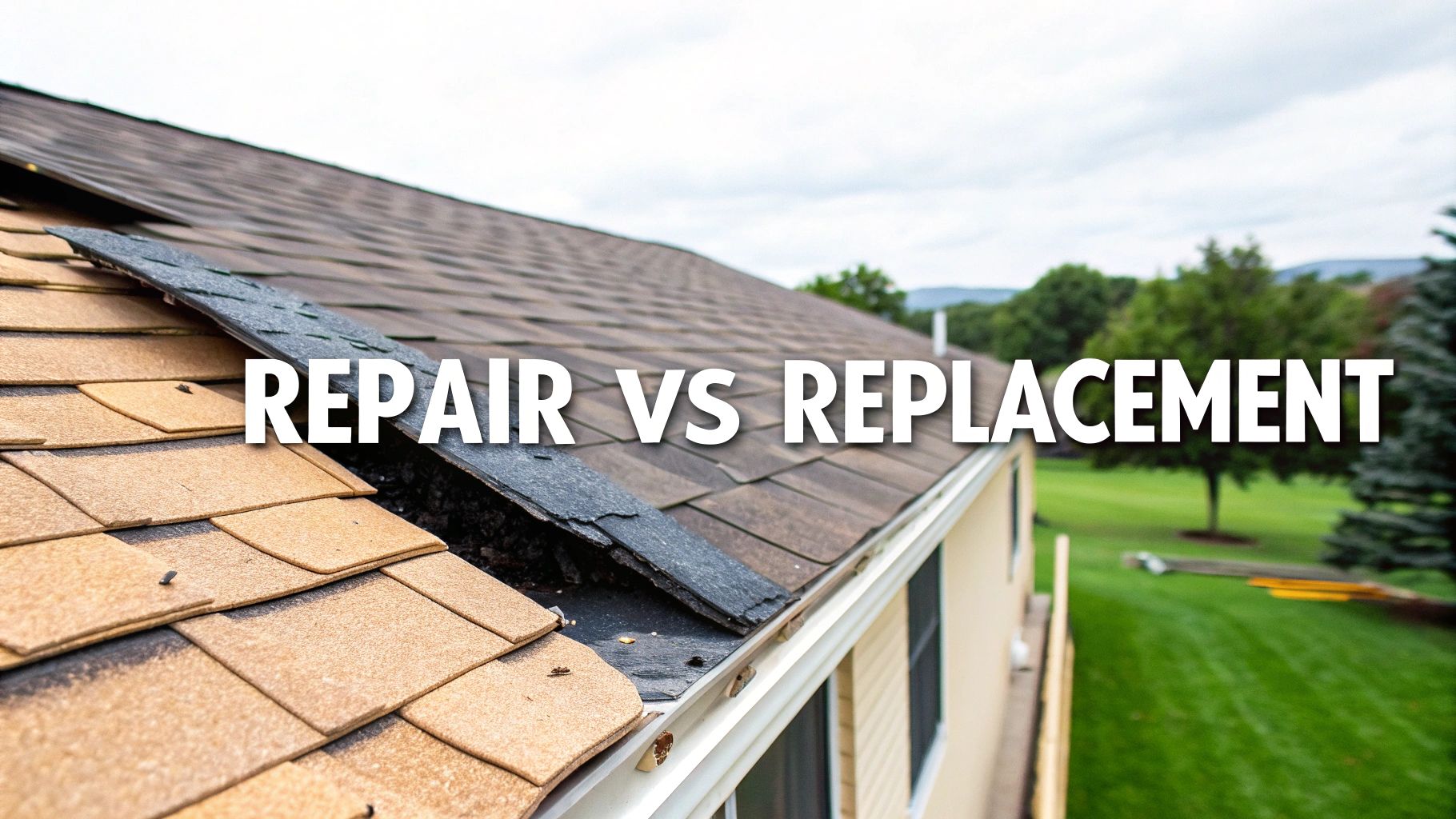Deciding between a roof replacement vs repair comes down to a clear question: are you solving a specific, isolated problem, or is your entire roof system failing? A repair is a targeted fix for a single trouble spot. A replacement is a complete overhaul for a roof that's old, tired, or has widespread damage. This guide gives you the actionable steps to make the right call for your home.
Deciding Between Roof Repair and Replacement
Choosing the right path isn't just about the immediate problem—it's about making a smart long-term investment. One option offers a quick, budget-friendly fix for a minor issue, while the other secures your home for decades. To make the right decision, you need to assess your roof's age, the extent of the damage, and your long-term financial goals.
Here's a practical example: a few shingles blown off in a storm on a 7-year-old roof? That's a textbook repair job. But if that same issue occurs on a 20-year-old roof already showing signs of aging, replacement is the more strategic move. This approach stops you from spending money on temporary fixes for a roof that is already near the end of its functional life.
Key Decision Factors
When helping homeowners, we focus on three core factors to guide their decision. Use these as your checklist:
- Age of the Roof: Most asphalt shingle roofs are designed to last 15-25 years. If your roof is approaching or has passed this age, a full replacement often provides better long-term value than repeated patches.
- Extent of Damage: Is the issue confined to one small area, or are problems appearing across the roof? A single leak or a small patch of missing shingles is typically repairable. However, widespread granule loss, curling shingles, or leaks in multiple rooms are clear indicators of a failing system that needs replacement.
- Long-Term Costs vs. Short-Term Savings: A repair is always cheaper upfront. But these repairs add up if you're calling a roofer annually. A replacement costs more initially but provides decades of protection and peace of mind, ending the cycle of frequent service calls.
To make this even clearer, here’s a direct comparison of what each option entails.
At a Glance Comparison: Repair vs Replacement
This table provides a scannable summary to help you weigh the critical factors for your decision.
| Decision Factor | Strategic Roof Repair | Full Roof Replacement |
|---|---|---|
| Initial Investment | Low | High |
| Project Duration | Typically 1-2 hours | Usually 1-3 days |
| Lifespan Extension | Varies (1-5 years for the repaired area) | 20-30+ years (for the entire system) |
| Impact on Property Value | Minimal | Significant positive impact |
As you can see, the choice impacts more than your immediate budget. It affects the long-term viability of your roof and the overall value of your home.
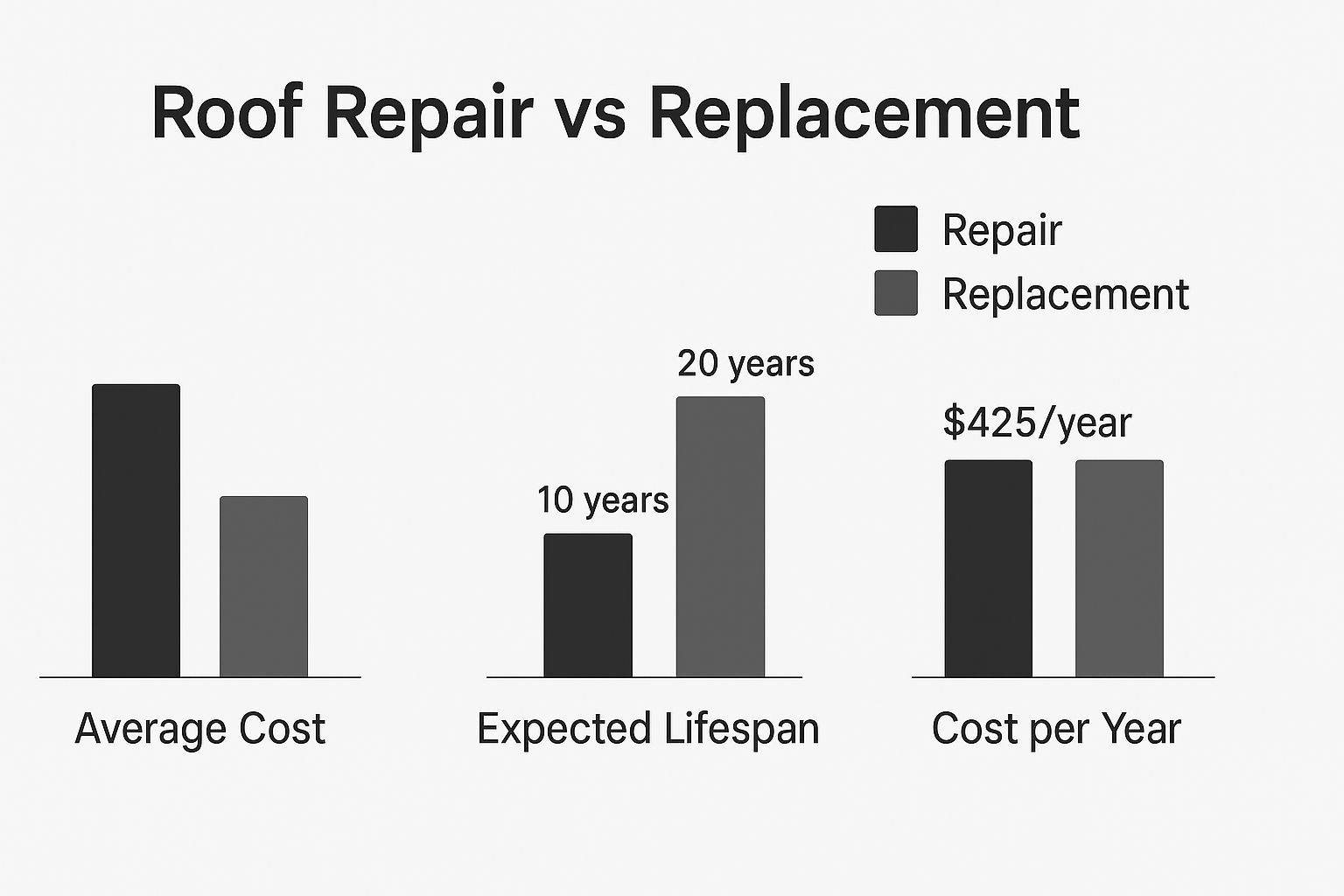
While the upfront cost of a replacement is higher, its incredible lifespan often leads to a lower cost-per-year. This perspective makes it clear why a new roof is such a sound long-term investment for your property.
The True Cost of Your Roofing Decision
When facing a roofing problem, it's easy to focus on the immediate price tag. To make a truly informed decision between repair and replacement, you must look beyond the initial quote and evaluate the long-term financial picture.
A repair is a smaller, targeted fix for a single issue. A replacement is a major overhaul of the entire system. The initial cost difference is significant, which often makes a repair seem like the obvious choice.
However, short-term thinking can be costly. The true cost of a roof isn't just the initial payment; it's the total amount you spend over its entire service life. Understanding this is key to making a financially sound decision.
Breaking Down the Numbers
Every roofing job consists of two primary costs: materials and labor. For a repair, this includes the cost of shingles or flashing for a specific area and the roofer's time. For a replacement, you're looking at these costs multiplied across your entire roof.
Current industry data highlights the difference. The average roof repair costs about $750, with a typical range from $300 for minor issues to over $2,000 for more significant damage.
In contrast, a full asphalt roof replacement for an average-sized home now averages around $30,680. This represents a nearly 15% increase since 2022, driven by rising material and labor costs. You can research recent roofing cost trends to understand what is driving these price changes.
Calculating the Cost Per Year of Life
To evaluate your options like an investor, calculate the cost-per-year-of-life. This metric reveals the true annual cost of your roof protection and clarifies its long-term value.
Here's a practical, actionable scenario:
- Repair Scenario: Your 18-year-old roof needs a $900 repair. If this fix extends its life by two years, your cost-per-year for that specific repair is $450.
- Replacement Scenario: You invest $30,000 in a new roof with a 25-year lifespan. Your cost-per-year for decades of protection is $1,200.
While the repair appears cheaper per year in this isolated case, remember that repairs on an aging roof are rarely a one-time event. If you need another $750 repair the following year, your annual cost increases dramatically.
The most expensive roof is the one you have to pay for twice. A cycle of frequent, costly repairs on an aging roof can easily surpass the long-term value of a replacement, turning short-term savings into a significant financial drain over time.
This is the central concept. If your roof is old or has widespread issues, a replacement resets the clock, giving you decades of predictable performance. A series of repairs, however, creates an unpredictable and frustrating cycle of expenses. This strategic mindset helps with financial planning, similar to how tools like WordPress plugins for SEO help organize digital goals, ensuring your choice delivers real, lasting value.
Clear Signs Your Roof Needs a Full Replacement
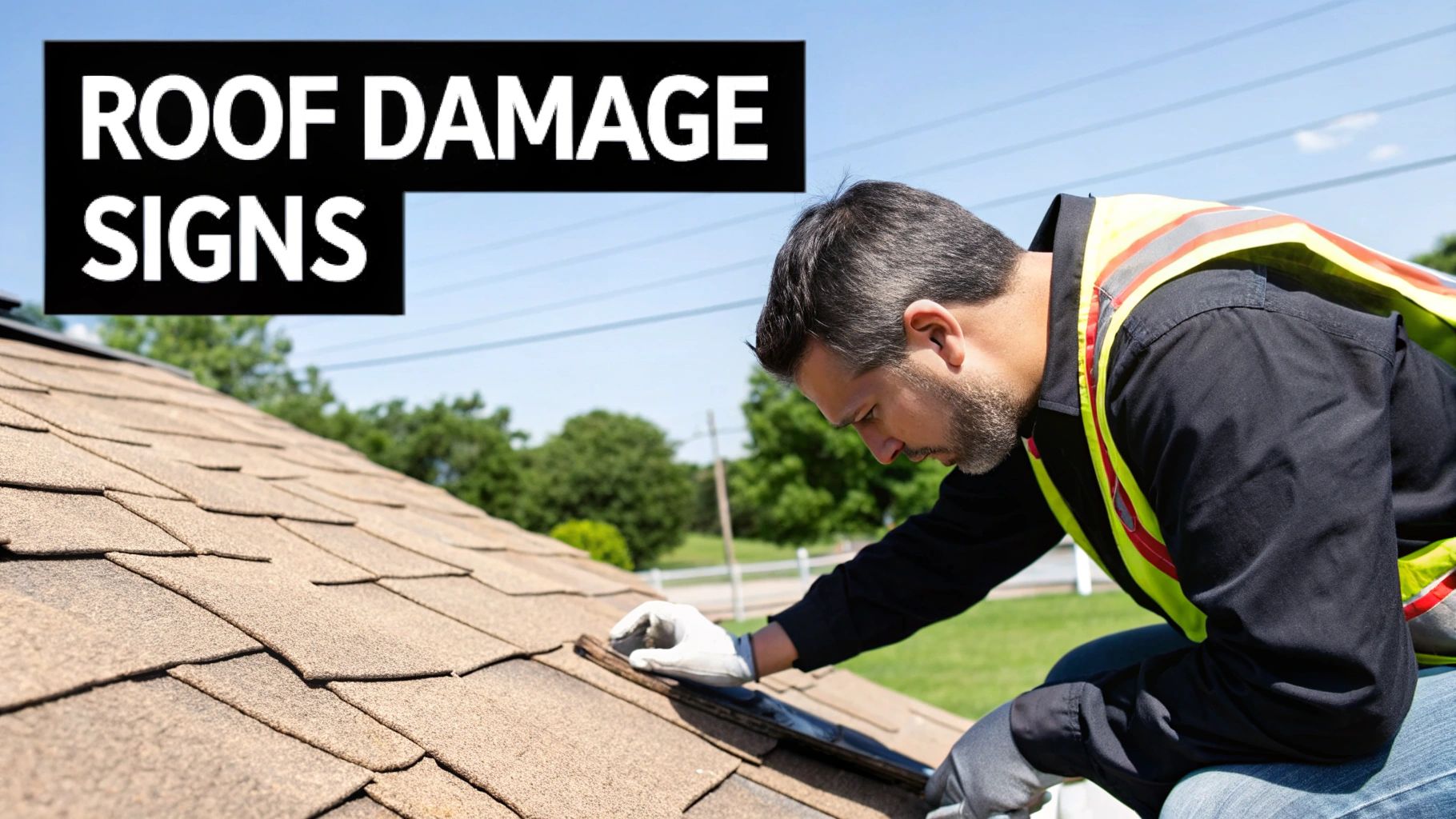
Sometimes, your roof makes the decision for you. While a professional can patch isolated issues, some widespread problems are clear signals that a complete overhaul is necessary.
Attempting to patch these systemic issues is like putting a bandage on a broken arm; it doesn't address the root cause. Spotting these red flags early helps you avoid wasting money on repairs that won't last. If you observe the following signs, a full replacement is the only safe and sensible action.
Your Roof Has Reached Its Expiration Date
The most straightforward indicator is age. A standard asphalt shingle roof is designed to last 20 to 25 years. If your roof is approaching or has surpassed this age, it’s living on borrowed time, regardless of its appearance from the ground.
After decades of exposure to sun, rain, and temperature fluctuations, the materials inevitably degrade. Adhesives weaken, asphalt dries out, and shingles lose their protective qualities. Applying new shingles over an old, failing system is a futile effort—you'll just be chasing one problem after another.
This is a significant consideration for homeowners worldwide, contributing to a residential roof replacement market valued at roughly $150 billion globally. As more homes reach this critical age, replacement becomes a necessity, a market trend detailed in full research from Data Insights Market.
Widespread Shingle Deterioration Is Apparent
Perform a visual inspection of your roof from several angles. Is the damage confined to one or two spots, or does the entire roof look worn? When the whole system is failing, you’ll see these tell-tale signs:
- Heavy Granule Loss: Check your gutters for an accumulation of coarse, black sand. These are the protective granules from your shingles. Once they are gone, the shingle's asphalt core is exposed to UV rays, which accelerates its decay.
- Curling or Clawing Shingles: Look for shingles curling up at the edges (cupping) or lifting in the middle (clawing). This is a classic sign of aging and heat damage, indicating the shingles are shrinking and can no longer lie flat to shed water effectively.
- Widespread Cracking: Don't dismiss a few cracked shingles. If you see numerous shingles with hairline fractures or larger cracks, it means they have become brittle. Your roof's primary defense is compromised and vulnerable to wind and water intrusion.
As a rule of thumb, if more than 30% of your roof is showing signs of curling, cracking, or major granule loss, replacement is almost always the smarter financial move. Repairing that much damage would be a temporary, labor-intensive nightmare.
The Roof Deck Feels Spongy or Soft
This is one of the most serious red flags and requires a careful on-roof inspection (only if you can do so safely). As you walk across the surface, pay attention to how it feels. If you detect any "spongy," soft, or bouncy spots, you have a critical structural problem.
This sponginess means water has penetrated your shingles and underlayment, causing the wooden sheathing underneath—the roof deck—to rot. This is not just a leak; it's a structural failure in progress.
No amount of shingle repair can fix this. The rotted decking must be removed and replaced to maintain your home's structural integrity. At this point, a full roof replacement is not just a recommendation; it is essential for the safety of your home and its occupants.
When a Strategic Roof Repair Is the Smart Move
While a failing roof requires a full replacement, jumping to that conclusion can be an expensive mistake. In many cases, a focused, strategic repair is the most intelligent and financially responsible choice. The key is to know when the problem is genuinely contained and a repair will provide lasting value.
A repair is the right call when the issue is isolated and the rest of your roof is in good condition. Think of it like a dentist filling a cavity—you wouldn't replace an entire row of healthy teeth. The goal is to resolve the specific problem without the high cost and disruption of a major project, extending the life of your existing roof.
Isolated Damage on a Newer Roof
The clearest scenario for choosing repair is when a relatively young roof sustains localized damage. If your roof is well under 15 years old and has been performing well, a total replacement for a small problem is almost always unnecessary.
Perhaps a severe thunderstorm lifted a few shingles, or a falling branch punctured one section. In these cases, a professional can remove the damaged materials and integrate new ones, restoring that spot to its original condition. The integrity of the rest of your roof remains intact, and you've solved the problem for a fraction of the cost of a replacement. The key is to act quickly before a minor issue escalates.
Minor Leaks Around Flashing and Penetrations
Many roof leaks originate not from widespread shingle failure, but from specific, vulnerable points. Flashing—the metal strips around chimneys, vents, and skylights—is a common culprit. Over time, the sealant around it can dry and crack, creating an entry point for water.
The same applies to the rubber boots around plumbing vents, which can become brittle and split with age. These are classic repair jobs. An experienced roofer can identify the leak's source, remove the failing material, and install a new, watertight seal. This type of precise, technical fix stops the leak and can add years to your roof's life.
The decision in a roof replacement vs repair debate often comes down to age. If your roof is less than 10-15 years old and the damage is just in one area, a repair is almost always the right call.
Maintaining Curb Appeal with a Seamless Repair
A common concern for homeowners is that a repair patch will be visually obvious and detract from their home's appearance. While this is a valid point, a skilled roofer can execute a repair that is both structurally sound and aesthetically pleasing. The first step is to match the shingle color and style.
On older roofs where sun exposure has faded the shingles, finding a perfect match can be challenging. In such cases, a roofer might use a clever technique: they can take original shingles from a less visible part of your roof (like the back) and use them for the repair on the front. The new shingles are then installed in the less conspicuous area. This strategic approach preserves your home's value and curb appeal, demonstrating that a repair can be both a wise and seamless solution. You can learn more about protecting your home's value in our guide to  .
.
Ultimately, proactive care is the best way to keep your roof in a repairable state for as long as possible. To see how this extends your roof's lifespan, check out these tips on preventive roof maintenance.
Understanding the Project Process and Timeline
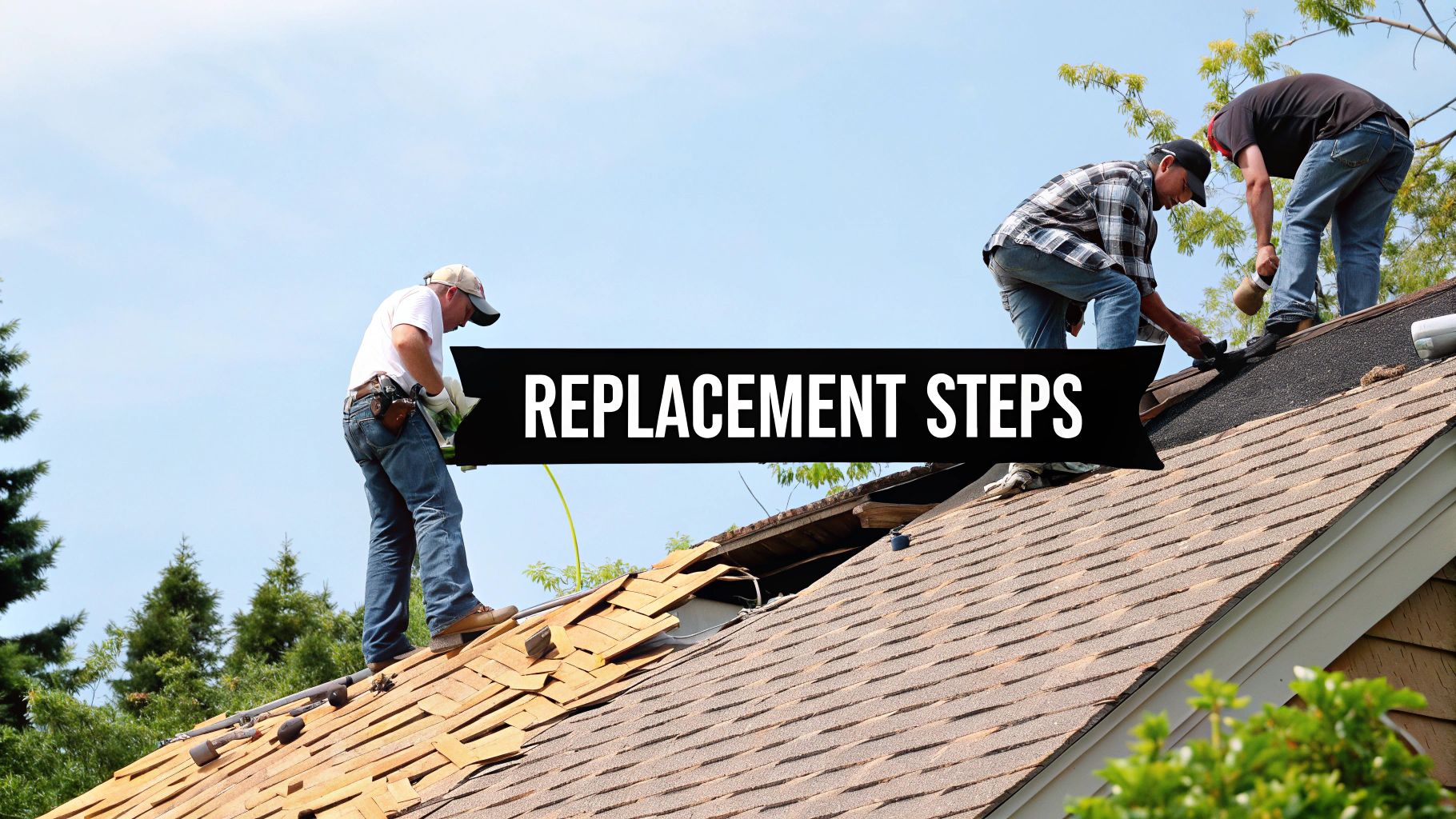
Knowing what to expect is half the battle. The daily disruption, noise, and overall timeline differ significantly when you’re debating roof replacement vs repair. Understanding what each job entails helps you prepare your home and family for the work ahead.
A roof repair is a quick, targeted procedure designed for minimal disruption. It is more like a surgical fix than a major operation.
A full roof replacement, conversely, is a multi-day construction project. It involves a full crew, significant noise, and a complex workflow from tear-off to final cleanup. For a project of this scale, effective home construction project management is essential to ensure a smooth and timely process.
Timeline and Homeowner Impact Comparison
To visualize the difference, it helps to break down the on-site activities for each project type. This table outlines the typical stages and what you can expect from a repair versus a full-scale replacement.
| Project Stage | Typical Repair Process | Typical Replacement Process |
|---|---|---|
| Inspection & Prep | A roofer confirms the specific damage and gets matching materials. | The crew preps the property with tarps and sets up for a multi-day project. |
| Duration | 1-3 hours on average. | 2-4 days, depending on roof size and complexity. |
| The Work Itself | Damaged materials are removed, the area is fixed, and new shingles are installed. | Full tear-off of old roofing, deck inspection/repair, installation of new underlayment and shingles. |
| Noise & Disruption | Minimal noise, usually confined to one area of the roof. | Significant noise from tear-off, nailing, and crew activity across the entire roof. |
| Cleanup | Quick cleanup of a small, localized area. | Extensive daily cleanup of the entire property perimeter to remove all debris and nails. |
As you can see, the impact on your daily life is drastically different. A repair is a minor inconvenience, while a replacement is a temporary but major disruption you need to plan for.
The Typical Roof Repair Workflow
A scheduled roof repair is typically completed within a few hours. The objective is to resolve the problem quickly and efficiently without disrupting your routine.
Here’s the standard process:
- Focused Inspection: The roofer identifies the precise source of the damage to ensure a complete fix.
- Material Sourcing: The contractor secures matching materials to create a seamless repair.
- The Fix: The core task involves removing damaged components, repairing any underlying issues, and installing new materials.
- Final Cleanup: The crew cleans up any debris, leaving your property as they found it.
The entire repair, from arrival to completion, is often finished in less than a day, and sometimes in just one or two hours. This makes it an ideal solution for a fast fix without the disruption of a major project.
The Full Roof Replacement Timeline
A roof replacement is a significant undertaking that unfolds over several days. Understanding the stages helps you anticipate the noise and activity.
Here’s a typical day-by-day breakdown:
- Day 1: Tear-Off and Deck Inspection: This is the loudest day. The crew removes all old shingles and underlayment, exposing the wooden deck. They then inspect the deck for rot or damage that must be replaced before proceeding.
- Day 2: Underlayment and Component Installation: The crew installs a new water-resistant underlayment, which serves as a critical second layer of defense. They also install new flashing, drip edges, and vents.
- Day 2-3: Shingle Installation and Final Touches: The new shingles are installed with precision, working from the eaves to the peak. The project concludes with the installation of the ridge cap and sealing all penetrations. A thorough cleanup of your property follows, leaving you with a brand-new, worry-free roof.
How Roofing Choices Impact Home Value and Efficiency
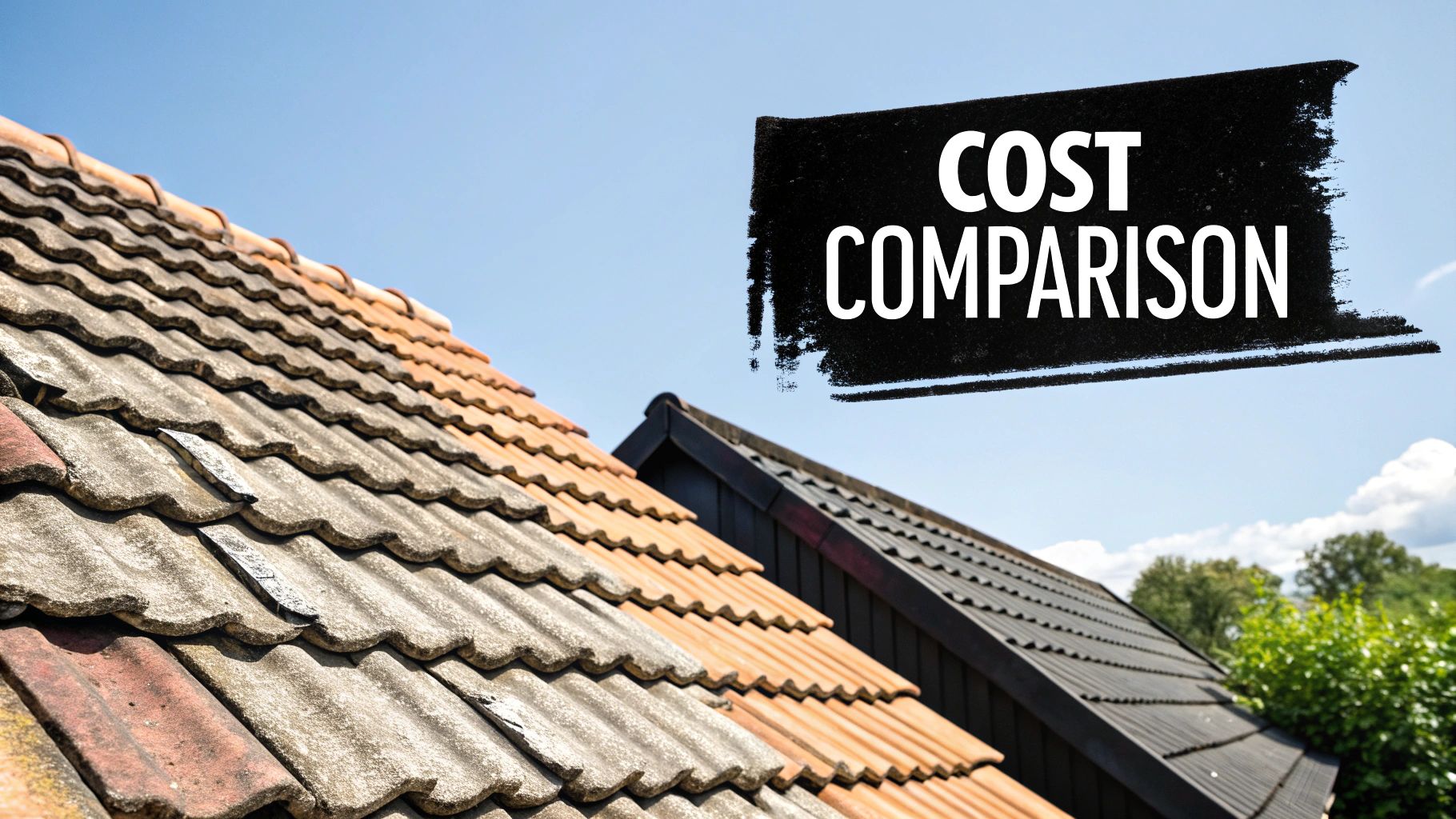
Your roofing decision is a major investment in your home's financial future. Whether you choose a repair or a replacement directly impacts your property's marketability, energy costs, and overall value. This perspective shifts the choice from a necessary expense to a strategic home improvement.
While a proper repair maintains your home's current condition, a full replacement actively enhances it. For prospective buyers, a new roof is a significant selling point, signaling that a major expense has already been handled. This can reduce your home's time on the market and increase the final sale price.
Boosting Curb Appeal and Resale Value
First impressions are crucial in real estate. A new roof instantly improves your home's exterior, giving it a clean, well-maintained appearance that boosts curb appeal. This visual upgrade can make your property highly attractive to buyers. It's a proven strategy used in many successful fix-and-flip projects because it delivers results.
Beyond aesthetics, a replacement offers a tangible return on investment (ROI). A new roof consistently ranks as one of the most valuable home improvements. It serves as a clear signal to appraisers and buyers that the home is structurally sound and protected for decades.
This is especially true in South Florida, where insurance carriers often require newer roofs to issue a policy. A full replacement can make your home easier and more affordable to insure, providing a powerful advantage during a sale.
Unlocking Long-Term Energy Savings
A significant benefit of a roof replacement is the opportunity to upgrade your home's energy efficiency. Modern roofing materials and installation techniques offer performance levels that older roofs cannot match. This focus on sustainable, energy-saving options is a major driver behind the global roofing market's projected growth from $214 billion in 2023 to $280 billion by 2029.
Consider the energy-saving upgrades possible with a replacement:
- Cool Roof Technology: You can install reflective shingles or apply special coatings that deflect the sun's heat. This reduces the workload on your AC system, leading to tangible savings on your monthly energy bills.
- Improved Attic Ventilation: A proper replacement includes creating a balanced ventilation system with soffit and ridge vents. This setup allows hot, humid air to escape the attic, preventing heat buildup in summer and moisture problems in winter.
- Enhanced Insulation: The tear-off phase is the perfect time to add or upgrade your attic insulation, creating a stronger thermal barrier for year-round comfort.
A new roof is more than a cover; it’s an active system that lowers your energy consumption. Over time, the savings from reduced cooling costs can significantly offset the initial investment.
In the roof replacement vs repair debate, only a full replacement unlocks these powerful efficiency upgrades. A patch job maintains the old standard, but a brand-new roof modernizes your home’s performance and adds value from day one. You can see how a modern roof ties a home's entire look together in this gallery of beautifully finished homes.
Frequently Asked Questions About Your Roof
Making the final call between a roof replacement and a repair is a significant decision. Here are clear answers to the most common questions we hear from homeowners to help you move forward with confidence.
Will My Homeowners Insurance Cover This?
Here is the direct answer: insurance typically covers sudden, accidental damage, such as from storms or falling trees (often called an "act of God"). It generally does not cover issues arising from old age, wear and tear, or lack of maintenance.
For instance, if a hurricane damages your roof, your policy will likely cover the repair or replacement. However, if your 25-year-old roof starts leaking due to age, the cost will likely be your responsibility. Your Action Step: Document any damage with photos immediately and call your insurance agent to review your specific coverage.
How Do I Find a Trustworthy Roofing Contractor?
Choosing a reliable roofer is the most critical step in the process. Ask for local referrals, but also conduct your own due diligence. Your Action Step: Verify that any potential contractor is licensed and fully insured. Ask for a list of recent customers you can contact for references.
A reputable roofer will never use high-pressure sales tactics to rush you. They should give you a detailed, written estimate that breaks down the scope of work, the specific materials they'll use, and the final cost.
Prioritize local companies with a physical address and a long-standing presence in the community. A contractor with a solid reputation and positive online reviews is more likely to stand behind their work.
What Is the Difference Between a Repair and Replacement Warranty?
Warranties are very different for repairs and replacements. A repair warranty is limited, covering only the specific area that was fixed. The labor warranty is typically short, often just 1-5 years, and offers no protection for the rest of your roof.
A full replacement warranty is far more comprehensive and includes two parts:
- Manufacturer's Warranty: This covers the materials (e.g., shingles) against defects, often for 20-30 years or more.
- Workmanship Warranty: This is provided by your contractor and covers installation errors. A quality roofer will offer a workmanship warranty of at least 10 years.
This is a critical factor in the roof replacement vs. repair decision. Only a new roof provides long-term, comprehensive protection for the entire system.
When you need straight answers and a team that puts you first, turn to Exact Roofing. We’re straight shooters who pride ourselves on honesty. If you need a repair, we'll recommend a repair. Period. We specialize in giving South Florida homeowners durable, high-quality roofing solutions. Get your free, no-pressure estimate and expert guidance by visiting us at https://www.exactcontractors.com.

